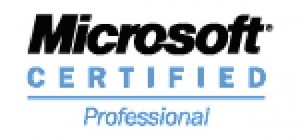 Yesterday, I took (and passed) the Microsoft Certification exam 70-536 (Technology Specialist: .NET Framework – Application Development Foundation). Three months worth of studying and it finally paid off.
Yesterday, I took (and passed) the Microsoft Certification exam 70-536 (Technology Specialist: .NET Framework – Application Development Foundation). Three months worth of studying and it finally paid off.
Just wanted to share. = )
 Yesterday, I took (and passed) the Microsoft Certification exam 70-536 (Technology Specialist: .NET Framework – Application Development Foundation). Three months worth of studying and it finally paid off.
Yesterday, I took (and passed) the Microsoft Certification exam 70-536 (Technology Specialist: .NET Framework – Application Development Foundation). Three months worth of studying and it finally paid off.
Just wanted to share. = )
For those of you keeping tabs, Microsoft recently released a slue of information regarding the next versions of Visual Studio and Team Foundation Server.
Some of the highlights…
Lots of exciting news out of Microsoft. I was kind of hoping that they’d release this yet in 2009, but I’m glad they’re taking the extra time to work out the bugs rather than rush the product to production too early.
For those of you keeping track, Microsoft released the new Visual Studio 2010 beta 1 release last week. I was a little disappointed – though not surprised – that, unlike with their September CTP, Microsoft did not provide a Virtual PC image for the Beta 1 release.
Like some of you out there, I prefer to show a little restraint when it comes to installing beta software on my personal machine. I prefer not to hose my computer intentionally, nor incur the wrath of my better half by denying her access to her e-mail and internet.
Fortunately, the people at Channel 9 care about marital bliss, and have therefore posted a step-by-step video guide explaining how to set up your ownVirtual PC – at no cost! The video shows you how to install Visual Studio Team Suite 2010 beta 1, TFS 2010 beta 1, and SQL Server 2008 running on Windows Server 2008. You don’t need an MSDN subscription to get this software, which means that some of it is going to be trial-based. But, it’s a great way to give the beta a test-run without risking detriment to your own PC.
My install was very straightforward, with the help of the video . It took me about 3 hours from start to finish, mostly waiting for installation progress bars to fill up. Performance will vary based on your internet connection (when downloading the various software), and how much CPU and memory you are able to allocate to the Virtual PC. Oh, and the finished .VHD file will likely weigh in at a hefty 15 GB, so make sure to account for that ahead of time.
Have fun!
The May 2009 MSDN Magazine has a good article reviewing XML comments and their usefulness for code development and documentation. The article is primarily written for VB developers, but the concepts do apply to C# developers as well.
I’ve been using XML comments since Visual Studio 2005 came out. For your VB developers still developing legacy .NET 1.1 / VS 2003 apps, you can install the VBCommenter add-in, which will give you some of the basic functionality (C# developers have this out-of-the-box).
If you’re not familiar with XML comments – or if you’ve heard of them, but haven’t tried them out yet – give the article a look.